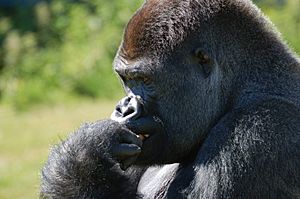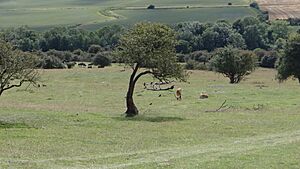Port Lympne Wild Animal Park facts for kids
| Date opened | 1976 |
|---|---|
| Location | Lympne, Kent, England (South Kent) |
| Land area | 600 acres (240 ha) |
| No. of animals | 650+ |
| No. of species | 50+ |
Port Lympne Hotel & Reserve is a large wildlife park and hotel located near Hythe in Kent, England. It covers about 600 acres (240 hectares) and is home to many rare and endangered animals. The park also includes the historic Port Lympne Mansion and beautiful gardens designed by Sir Herbert Baker.
The estate was bought in 1973 by John Aspinall. He wanted more space for animals from his other park, Howletts Wild Animal Park. Port Lympne first opened to the public in 1976. Since 1984, a charity called The John Aspinall Foundation has owned the parks. This charity is now led by Damian Aspinall. The park is known for its special way of caring for animals, encouraging close bonds between staff and animals. They also do important work breeding rare and endangered species. Today, you can see tigers, lions, leopards, gorillas, bears, giraffes, and the UK’s largest group of black rhinos here. The park even plans to release some animals back into the wild.
Many famous people and even royalty have stayed at the mansion inside the park. The rooms are very fancy, and the gardens offer amazing views of Romney Marsh. There are also many other cool places to stay at the park, like Lion Lodge, Tiger Lodge, Bear Lodge (which is like fancy camping), and Giraffe Hall.
Contents
Explore the Dinosaur Forest
Opened in 2016, the Dinosaur Forest is a fun area where you can see life-sized dinosaurs. These models are made to look exactly like real dinosaurs from millions of years ago. Park rangers are there to tell you all about these ancient creatures. You can even try digging for fossils or creating your own dinosaur!
Amazing Animal Collection
Port Lympne is home to many rare and endangered animals. It has the biggest breeding group of black rhinoceros in the UK. You can also see Siberian tigers, small cats, monkeys, Malayan tapirs, Barbary lions, African hunting dogs, and many more. Some animals are along a walking path. There's also an open area where you can see rhinos and colobus monkeys.
The park offers an 'African Experience' safari trail. Visitors ride in special vehicles to see animals like rhinoceros, giraffe, zebra, deer, and wildebeest roaming in large open spaces.
In 2015, Port Lympne moved its group of Asian elephants to other parks. This was done to help with breeding programs and focus on their African elephants. Now, they have three African elephant cows from Howletts Wild Animal Park and a bull named Kruger from Knowsley Safari Park. Howletts has the largest group of African elephants in the UK.
Helping Animals Return to the Wild
The Aspinall Foundation works hard to help animals born in the park go back to their natural homes in the wild. They work with governments in Congo-Brazzaville and Gabon to protect a huge area of land. This area is about one million acres in the Batéké Plateau.
The Foundation has successfully reintroduced over 60 gorillas into the wild. This includes 22 gorillas that came from their parks in Kent. They have also helped eight black rhinos born in Kent return to the wild.
Releasing animals into the wild can be very challenging. Sometimes, it doesn't go as planned. For example, some gorillas released in 2014 faced difficulties. However, the Foundation continues its important work to protect and reintroduce endangered species. They believe it's vital to give these animals a chance to live freely in their natural habitats.
Animal Enclosures and Experiences
The park is divided into two main parts. In one part, you can walk around or use golf buggies to see animals in their enclosures. This area has primates and big cats. The other part is a safari park. You ride in open-sided trucks through different sections: South American, Asian, and African safaris. The park has nearly 90 different kinds of animals across its 600 acres.
Palace of the Apes
The Palace of the Apes is the world's largest gorillarium. It is home to a big breeding family of Western lowland gorillas. In late 2018, the park announced the passing of Babydoll, who was 57 years old and known as "Britain's oldest" gorilla. Damian Aspinall has dedicated his life to gorilla conservation, following in his father's footsteps.
African Experience Safari
The African Experience is a large area, about 100 acres. It is home to many different African animals, including:
- Rothschild's giraffe
- Chapman's Zebra
- Black Rhino
- Defassa Waterbuck
- Dwarf Forest Buffalo
- Hog Deer
- Axis Deer
- Roan Antelope
- Ostrich
- Blue Wildebeest
- Red Lechwe
- Common Eland
- Blackbuck
Asian Experience Safari
This safari area is smaller than the African one. It is home to many different Asian animals, such as:
- Mishmi takin
- Hog deer
- Axis deer
- Asian water buffalo
- Wild Bactrian camel
- Blackbuck
- Barasingha
- Pere David's deer
- Przewalski's horse
- Sambar deer
South American Experience Safari
This is the newest and smallest of the three safari areas. It is the only place in Kent where you can see Andean (or spectacled) bears. It also has many other South American animals, including:
Discovery Zone
The park used to have a small area called the Discovery Zone. It was home to meerkats, pygmy marmosets, and various reptiles and insects. However, the Discovery Zone is now closed to the public.
Port Lympne on Television
The BBC children's TV show Roar was filmed at both Port Lympne and Howletts Wild Animal Park. The show was broadcast on BBC Two and the CBBC channel. It took viewers behind the scenes, showing how the animal keepers cared for the animals.




